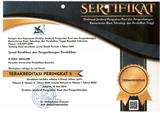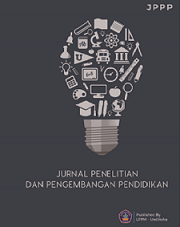Student Learning Difficulties in Terms of the STIF in Framework of Fractional Material
DOI:
https://doi.org/10.23887/jppp.v7i2.57371Keywords:
Learning Difficulties, STIFIn, Mathematics, Elementary SchoolAbstract
Learning mathematics is possible because of problems in learning facts, concepts, operations and principles. Students who need help teaching mathematics often make mistakes in counting. This research aims to analyze the difficulties experienced by students in fractional material with the types of intelligent thinking, feeling and sensing in learning mathematics. This research approach uses a qualitative approach to document study and interviews. The sample in this study was fourth-grade elementary school students. The sampling technique used is random sampling. Primary data and secondary data are the source of data in this study. The instrument used is in the form of interview sheets and questions regarding fractional material in mathematics lessons. Data analysis was carried out based on the Miles and Huberman model. Based on the results of the STIFIn test, it was found that the Feeling, Sensing and Thinking students were superior in mastering the concept of fractions to the Instinct and Intuiting students. Furthermore, students' strategies in developing fractional problem-solving strategies are comparing fractions with other simple standard fractions, comparing fractions based on the denominator and quantifier, and making fraction representations in the form of flat structures to understand and compare fractions.
References
Abdurrahman, S., & Kibtiyah, A. (2021). Strategi Mengatasi Masalah Kesulitan Belajar Siswa Dengan Memahami Gaya Belajar Siswa (Studi Kasus Di Ma Al-Ahsan Bareng. Jurnal Pendidikan Tambusai, 5(3), 6444–6454. https://doi.org/10.31004/jptam.v5i3.1964.
Agustina, S., Saman, W. S. W. M., Shaifuddin, N., & Aziz, R. A. (2022). Reading material selection for bibliotheraphy based on blood type in young adult groups. Jurnal Kajian Informasi & Perpustakaan, 10(1), 89–106. https://doi.org/10.24198/jkip.v10i1.31022. DOI: https://doi.org/10.24198/jkip.v10i1.31022
Alindra, A. L. (2018). Kajian aksiologi metode STIFIn dalam pemetaan mesin kecerdasan manusia. Titian Ilmu: Jurnal Ilmiah Multi Sciences, 10(2), 64–73. https://doi.org/10.30599/jti.v10i2.206. DOI: https://doi.org/10.30599/jti.v10i2.206
Amaliyah, A., Oktaviani, D., & Nurrahma, M. I. (2022). Analisis Pengolahan Data Dengan Menggunakan Metode Stad. Jurnal Sains Dan Teknologi (JSIT, 2(2), 1–7. https://doi.org/10.22210/jsit.v2i1.57.
Asbari, M., Nurhayati, W., & Purwanto, A. (2019). The effect of parenting style and genetic personality on children character development. Jurnal Penelitian Dan Evaluasi Pendidikan, 23(2), 206–218. https://doi.org/10.21831/pep.v23i2.28151. DOI: https://doi.org/10.21831/pep.v23i2.28151
Astalini, A., Darmaji, D., Kurniawan, D. A., & Azzahra, M. Z. (2022). Comparative analysis and student response relationships regarding the inquiry learning model on students’ attitudes and character. AL-ISHLAH: Jurnal Pendidikan, 14(4), 5907–5922. https://doi.org/10.35445/alishlah.v14i4.2092. DOI: https://doi.org/10.35445/alishlah.v14i4.2092
Ayu, M. (2020). Online learning: Leading e-learning at higher education. The Journal of English Literacy Education: The Teaching and Learning of English as a Foreign Language, 7(1), 47–54. https://doi.org/10.36706/jele.v7i1.11515. DOI: https://doi.org/10.36706/jele.v7i1.11515
Badriyah, N., Sukamto, S., & Subekti, E. E. (2020). Analisis Kesulitan Belajar Siswa Dalam Menyelesaikan Soal Cerita Matematika Pada Materi Pecahan Kelas III SDN Lamper Tengah 02. Pedagogik: Jurnal Pendidikan, 15(1), 10–15. https://doi.org/10.33084/pedagogik.v15i1.1279. DOI: https://doi.org/10.33084/pedagogik.v15i1.1279
Borromeo Ferri, R. (2010). On the influence of mathematical thinking styles on learners’ modeling behavior. Journal Für Mathematik-Didaktik, 31(1), 99–118. https://doi.org/10.1007/s13138-010-0009-8. DOI: https://doi.org/10.1007/s13138-010-0009-8
Capuno, R., Necesario, R., Etcuban, J. O., Espina, R., Padillo, G., & Manguilimotan, R. (2019). Attitudes, Study Habits, and Academic Performance of Junior High School Students in Mathematics. International Electronic Journal of Mathematics Education, 14(3), 547–561. https://doi.org/10.29333/iejme/5768. DOI: https://doi.org/10.29333/iejme/5768
Cresswell, C., & Speelman, C. P. (2020). Does mathematics training lead to better logical thinking and reasoning? A cross-sectional assessment from students to professors. PLoS One, 15(7). https://doi.org/10.1371/journal.pone.0236153. DOI: https://doi.org/10.1371/journal.pone.0236153
Cunaya, C., & Apriyansyah, C. (2022). Analisis Perkembangan Sosial Emosional Anak Usia 5-6 Tahun Melalui Asesment Wawancara Di TK Cahaya Bintang. Cemerlang: Jurnal Pendidikan Anak Usia Dini, 1(1), 1–9. https://doi.org/https://cemerlang-paud-pancasakti.ac.id/index.php/cemerlang/article/view/1.
Dodi, L., Huda, M., & Sufirmansyah, S. (2021). Grounding the Vision of Religious Moderation as a Strategic Step in Preparing the Next Generation of the Nation towards Global Era. Proceedings of the 2nd International Conference on Islamic Studies, ICIS 2020, 27–28. https://doi.org/10.4108/eai.27-10-2020.2304176. DOI: https://doi.org/10.4108/eai.27-10-2020.2304176
Ernawati, M. D. W., Sudarmin, S., Asrial, A., Haryanto, H., Sanova, A., Kurniawan, D. A., & Azzahra, M. Z. (2021). The Influence of Student Interest on Student Learning Outcomes in Science Subjects. Jurnal Pendidikan Sains Indonesia (Indonesian Journal of Science Education, 10(4), 849–861. https://doi.org/10.24815/jpsi.v10i4.25306. DOI: https://doi.org/10.24815/jpsi.v10i4.25306
Farida, K. (2022). Aplikasi Metode STIFIn dan ILHAM terhadap Hasil Hafalan Al-QUran (Eksperimen terhadap Mahasantri Institut Ilmu Al-Quran Jakarta. JURNAL LENTERA: Kajian Keagamaan, Keilmuan Dan Teknologi, 21(1), 52–69. https://doi.org/http://www.ejournal.staimnglawak.ac.id/index.php/lentera/article/view/611.
Fitzsimons, E. (2015). Character education: A role for literature in cultivating character strengths in adolescence. Master of Applied Positive Psychology, 8(1), 135–150. https://doi.org/10.1007/978-94-017-9667-5_7. DOI: https://doi.org/10.1007/978-94-017-9667-5_7
Fuadi, R., Johar, R., & Munzir, S. (2022). Peningkatkan Kemampuan Pemahaman dan Penalaran Matematis melalui Pendekatan Kontekstual. Jurnal Didaktik Matematika, 3(1), 47–54. https://doi.org/10.24815/jdm.v3i1.4305.
Haryanto, H., Kurniawan, D. A., Oktavia, N. E., Ariani, D. R., Rahman, A. A., & Azzahra, M. Z. (2016). Attitude and Interest Junior High School Students: How Difference and Correlation in Science Learning. Jurnal Penelitian Pendidikan IPA, 8(6), 2575–2585. https://doi.org/10.29303/jppipa.v8i6.1896. DOI: https://doi.org/10.29303/jppipa.v8i6.1896
Jamal, F. (2019). Analisis kesulitan belajar siswa dalam mata pelajaran matematika pada materi peluang kelas XI IPA SMA Muhammadiyah Meulaboh Johan Pahlawan. MAJU: Jurnal Ilmiah Pendidikan Matematika, 1(1). https://www.ejournal.stkipbbm.ac.id/index.php/mtk/article/view/232.
Kamid, K., Anwar, K., Iriani, D., & Nawahdani, A. M. (2021). Analysis of interest and process skills in learning mathematics. Jurnal Riset Pendidikan Matematika, 8(2), 10 21831 8 2 42640. https://ejournal.undiksha.ac.id/index.php/JERE/article/view/37183. DOI: https://doi.org/10.21831/jrpm.v8i2.42640
Kamid, K., Iriani, D., & Nawahdani, A. M. (2022). Scientific Learning and Process Skills Mathematics: Comparison and Relationship. JPI (Jurnal Pendidikan Indonesia, 11(2). https://doi.org/10.23887/jpiundiksha.v11i2.37158. DOI: https://doi.org/10.23887/jpiundiksha.v11i2.37158
Kenedi, A. K., Helsa, Y., Ariani, Y., Zainil, M., & Hendri, S. (2019). Mathematical Connection of Elementary School Students to Solve Mathematical Problems. Journal on Mathematics Education, 10(1), 69–80. https://doi.org/https://eric.ed.gov/?id=EJ1204804. DOI: https://doi.org/10.22342/jme.10.1.5416.69-80
Miles, M. B., Huberman, A. M., & Saldana, J. (2014). Qualitative Data Analysis. Sage Publication.
Mundiri, A., & Zahra, I. (2017). Implementasi metode STIFIn dalam meningkatkan kemampuan menghafal Al-Qur’an di rumah Qur’an STIFIn Paiton Probolinggo. Jurnal Pendidikan Agama Islam (Journal of Islamic Education Studies, 5(2), 201–223. https://doi.org/10.15642/jpai.2017.5.2.201-223. DOI: https://doi.org/10.15642/jpai.2017.5.2.201-223
Natasya, N. (2019). Analisis Faktor Penyebab Kesulitan Belajar Matematika di Kelas IV Sekolah Dasar Negeri 004 Bangkinang Kota (Materi Pecahan. Jurnal Riset Pembelajaran Matematika Sekolah, 3(2), 47–53. https://doi.org/10.21009/jrpms.032.06. DOI: https://doi.org/10.21009/jrpms.032.06
Nawahdani, A. M., Kurniawan, D. A., & Melisa, D. (2021). Analisis Model Project Based Learning Terhadap Keterampilan Proses Sains Peserta Didik Pada Mata Pelajaran Fisika. Prosiding Seminar Nasional Matematika Dan Sains, 3(1), 348–354. https://doi.org/https://prosiding.biounwir.ac.id/article/view/185.
Novikasari, I. (2017). Hubungan Antara Prestasi Belajar Dan Tingkat Kecemasan Matematika Pada Mahasiswa Calon Guru SD/MI. Jurnal Aksioma, 5(2). https://doi.org/10.24127/ajpm.v5i2.671. DOI: https://doi.org/10.24127/ajpm.v5i2.671
Octavyanti, N. P. L., & Wulandari, I. G. A. A. (2021). Pengembangan Video Pembelajaran Berbasis Pendekatan Kontekstual Pada Mata Pelajaran Matematika Kelas IV SD. Jurnal Edutech Undiksha, 9(1), 66–74. https://doi.org/10.23887/jeu.v9i1.32223. DOI: https://doi.org/10.23887/jeu.v9i1.32223
Poniman, F., & Amalia, N. (2019). A Grand Theory of STIFIn Personality: Basic Functions Theory Revisited. https://mail.easychair.org/publications/preprint/QgPw. DOI: https://doi.org/10.37200/IJPR/V24I5/PR201737
Putridayani, I. B., & Chotimah, S. (2020). Analisis Kesulitan Belajar Siswa Dalam Pelajaran Matematika Pada Materi Peluang. MAJU: Jurnal Ilmiah Pendidikan Matematika, 7(1). https://www.ejournal.stkipbbm.ac.id/index.php/mtk/article/view/426.
Ramalisa, Y. (2013). Proses Berpikir Kritis Siswa SMA Tipe Kepribadian Thinking dalam Memecahkan Masalah Matematika. Edumatica, 03(01), 42–47. https://doi.org/10.22437/edumatica.v3i01.1407.
Roffiq, A., Qiram, I., & Rubiono, G. (2017). Media musik dan lagu pada proses pembelajaran. JPDI (Jurnal Pendidikan Dasar Indonesia, 2(2), 35–40. https://doi.org/10.26737/jpdi.v2i2.330. DOI: https://doi.org/10.26737/jpdi.v2i2.330
Rosanti, A., Tahir, M., & Maulyda, M. A. (2022). Analisis Kesulitan Belajar Matematika Materi Penjumlahan dan Pengurangan Pada Kelas II di SDN 3 Pringgajurang. Jurnal Ilmiah Profesi Pendidikan, 7(3), 1490–1495. https://doi.org/10.29303/jipp.v7i3b.812. DOI: https://doi.org/10.29303/jipp.v7i3b.812
Runtukkahu, J. T. (2014). Pembelajaran Matematika Dasar bagi Anak Berkesulitan Belajar. Pustaka Pelajar. http://library.uny.ac.id/sirkulasi/index.php?p=show_detail&id=49629&keywords=pembelajaran+matematika+dasar.
Safriani, W., Munzir, S., Duskri, M., & Maulidi, I. (2019). Analysis of Students’ Errors on the Fraction Calculation Operations Problem. Al-Jabar: Jurnal Pendidikan Matematika, 10(2), 307–318. https://doi.org/10.24042/ajpm.v10i2.5224. DOI: https://doi.org/10.24042/ajpm.v10i2.5224
Sanjaya, R. (2020). 21 Refleksi Pembelajaran Daring di Masa Darurat. SCU Knowledge Media.
Sholeh, A. H., Khasanatin, A. A., & Rena, S. (2022). Implementasi Metode STIFIN dalam Meningkatkan Karakter Islami Peserta Didik di Sekolah Alam. Idrak: Journal of Islamic Education, 4(2). http://jurnal.stit-rh.ac.id/index.php/idrak/article/view/38.
Simanullang, P. (2022). Application of Introduction To Personality Psychology 5 Genetic Intelligence Through The Concept of Stifin Test. ENGGANG: Jurnal Pendidikan, Bahasa, Sastra, Seni, Dan Budaya, 3(1), 100–109. https://doi.org/10.37304/enggang.v3i1.5214. DOI: https://doi.org/10.37304/enggang.v3i1.5214
Supena, I., Darmuki, A., & Hariyadi, A. (2021). The Influence of 4C (Constructive, Critical, Creativity, Collaborative) Learning Model on Students’ Learning Outcomes. International Journal of Instruction, 14(3), 873–892. https://eric.ed.gov/?id=EJ1304598. DOI: https://doi.org/10.29333/iji.2021.14351a
Syaputra, A. (2022). Implementasi Metode Random Sampling Pada Animasi Motion Grapich Herbisida Dan Fungisida. Jurnal Sisfokom (Sistem Informasi Dan Komputer, 11(2), 142–147. https://doi.org/10.32736/sisfokom.v11i2.1370. DOI: https://doi.org/10.32736/sisfokom.v11i2.1370
Timang, M., Nadeak, B., & Sihotang, H. (2021). the Influence of the Principal’S Managerial Ability, Training and Spiritual Intelligence on Teacher Performance At Smpn 1 Rantepao. International Journal of Research-GRANTHAALAYAH, 9(1), 248–256. http://repository.uki.ac.id/4126/. DOI: https://doi.org/10.29121/granthaalayah.v9.i2.2021.3526
Unaenah, E., Siregar, E. R., Nurjamilah, P., Ramadhanty, S., & Sarah, S. (2022). Analisis Kesulitan Siswa pada Pembahasan Materi Pengelolaan Data Kelas VI SDN Kalideres 06 Pagi. ARZUSIN, 2(4), 332–342. https://doi.org/10.58578/arzusin.v2i4.452. DOI: https://doi.org/10.58578/arzusin.v2i4.452
Utari, D. R., Wardana, M. Y. S., & Damayani, A. T. (2019). Analisis kesulitan belajar matematika dalam menyelesaikan soal cerita. Jurnal Ilmiah Sekolah Dasar, 3(4), 534–540. https://doi.org/10.23887/jisd.v3i4.22311. DOI: https://doi.org/10.23887/jisd.v3i4.22311
Witkin, H. A., Moore, C. A., Goodenough, D. R., & Cox, P. W. (1977). Field-dependent and field-independent cognitive styles and their educational implications. Review of Educational Research, 47(1), 1–64. https://journals.sagepub.com/doi/abs/10.3102/00346543047001001?journalCode=rera. DOI: https://doi.org/10.3102/00346543047001001
Yuniawardani, V., & Mawardi. (2018). Peningkatan Hasil Belajar Pada Pembelajaran Matematika Dengan Model Problem Based Learning Kelas IV SD. Jurnal Riset Teknologi Dan Inovasi Pendidikan, 1(2), 24–32. https://doi.org/10.31764/justek.v1i1.416. DOI: https://doi.org/10.31764/justek.v1i1.416
Yusanto, Y. (2020). Ragam Pendekatan Penelitian Kualitatif. Journal of Scientific Communication (Jsc, 1(1). https://doi.org/10.31506/jsc.v1i1.7764. DOI: https://doi.org/10.31506/jsc.v1i1.7764
Downloads
Published
How to Cite
Issue
Section
License
Copyright (c) 2023 Kamid, Rina Kusuma Dewi, Yelli Rahmalisa, Miftahul Zannah Azzahra, Ahmad Mansur Nawahdani, Nelva Maudia

This work is licensed under a Creative Commons Attribution-ShareAlike 4.0 International License.
Authors who publish with the Jurnal Penelitian dan Pengembangan Pendidikan agree to the following terms:
- Authors retain copyright and grant the journal the right of first publication with the work simultaneously licensed under a Creative Commons Attribution License (CC BY-SA 4.0) that allows others to share the work with an acknowledgment of the work's authorship and initial publication in this journal.
- Authors are able to enter into separate, additional contractual arrangements for the non-exclusive distribution of the journal's published version of the work (e.g., post it to an institutional repository or publish it in a book), with an acknowledgment of its initial publication in this journal.
- Authors are permitted and encouraged to post their work online (e.g., in institutional repositories or on their website) prior to and during the submission process, as it can lead to productive exchanges, as well as earlier and greater citation of published work. (See The Effect of Open Access)







